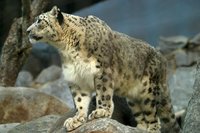Snow Leopard
|
|
| Snow Leopard Conservation status: Endangered | ||||||||||||||
|---|---|---|---|---|---|---|---|---|---|---|---|---|---|---|
 | ||||||||||||||
| Scientific classification | ||||||||||||||
| ||||||||||||||
| Binomial name | ||||||||||||||
| Uncia uncia (Schreber, 1775) |
The Snow Leopard or Ounce (Uncia uncia) is a large cat native to the mountain ranges of central Asia. Until recently many taxonomists included the Snow Leopard in the genus Panthera with several of the other largest felids. It is not a true leopard. It is much smaller.
Weighing up to 75 kilograms, the snow leopard can be distinguished from other similar species by its proportionately long tail. The tail helps the animal to maintain its balance on the often steep slopes of its mountainous environment, and is used to cover its nose and mouth in very cold conditions. The males head is usually much squarer and wider than one of a females. Its big furry feet act as snowshoes, like those of the Lynx. In summer they usually live above the tree-line on mountainous meadows and in rocky regions at an altitude of up to 6000 m. In winter they come down into the forests at an altitude of about 2000 m. They lead largely solitary lives.
Snow Leopards have gray-and-white fur with numerous rosettes on the flanks and spots on the head and neck, similar to jaguars. Tails are striped. They are opportunistic feeders, eating whatever meat they may find; they often kill animals three times their size, including domestic livestock. They also ambush prey from above when possible. Their diet consists of Ibex, Bharal, as well as Marmots and other small rodents.
The Snow Leopard is an endangered species whose pelts command a very high price in the fur market. During the 1960s total population went down to 1000 animals, but has recovered meanwhile to more than 6000 animals.
Snow Leopards are successfully bred in captivity. Snow Leopards give birth to 2 to 3 cubs in a litter on average but can give birth to up to 7!
